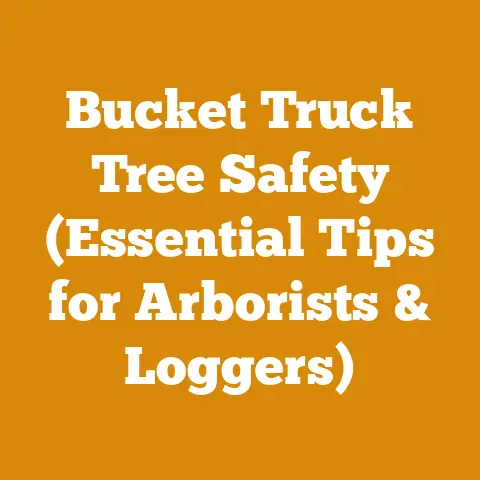The Earth Stove Models: Efficient Wood Processing Tips (Pro Hacks)
Ah, the Earth Stove. A classic piece of heating technology, but like any equipment, it’s prone to wear and tear, especially when you’re relying on it to burn efficiently-processed wood. Over the years, I’ve seen countless Earth Stoves, and the key to their longevity is simple: properly prepared firewood. This guide isn’t just about splitting logs; it’s about maximizing the efficiency of your Earth Stove, reducing maintenance, and getting the most heat out of every cord. I’m going to share some pro hacks I’ve learned over years in the wood processing and firewood preparation business. Let’s dive in!
Understanding Your Earth Stove’s Needs
The Earth Stove is designed to burn wood at optimal efficiency. However, that efficiency hinges on the wood you feed it. Not all wood is created equal, and neither is all firewood.
The Moisture Content Imperative
For an Earth Stove to operate at its peak, the moisture content of your firewood needs to be below 20%. Wet wood doesn’t just burn poorly; it creates creosote, a tar-like substance that can build up in your chimney and pose a significant fire hazard. I can recall one winter where a customer, adamant that his wood was “dry enough,” ended up with a chimney fire that nearly cost him his home. He learned the hard way that a moisture meter is more reliable than guesswork.
- Why 20%? Wood with a moisture content above 20% wastes energy boiling off water before it can actually burn. This results in less heat, more smoke, and increased creosote buildup.
- How to Measure: Invest in a reliable moisture meter. Insert the probes into a freshly split piece of wood to get an accurate reading. I recommend taking several readings from different pieces to ensure consistency.
- My Experience: I once processed a batch of oak that I thought was ready to go. The moisture meter told a different story. It needed another few months of seasoning. Patience paid off; that batch burned cleaner and hotter than any I had prepared before.
Wood Species and Heat Output
Different wood species have different heat outputs, measured in British Thermal Units (BTUs). Hardwoods like oak, maple, and birch are denser and contain more energy than softwoods like pine and fir.
- Hardwoods vs. Softwoods: Hardwoods generally provide more heat per volume and burn longer than softwoods. However, softwoods ignite more easily, making them good for kindling.
- BTU Ratings:
- Oak: ~27 million BTU per cord
- Maple: ~24 million BTU per cord
- Birch: ~20 million BTU per cord
- Pine: ~15 million BTU per cord
- My Recommendation: A mix of hardwoods for sustained heat and softwoods for quick starts is ideal. I usually aim for a 70/30 split, favoring hardwoods.
Size Matters: Proper Firewood Dimensions
The size of your firewood is crucial for efficient burning. Pieces that are too large may smolder and produce smoke, while pieces that are too small may burn too quickly.
- Ideal Dimensions: For most Earth Stoves, firewood should be split to a length of 16-18 inches and a diameter of 4-6 inches. This allows for good airflow and efficient combustion.
- My Rule of Thumb: I use a measuring stick marked at 16 and 18 inches. This ensures consistent lengths. As for diameter, I aim for pieces that are easy to handle but not so small that they burn up in minutes.
Essential Tools for Efficient Wood Processing
Having the right tools can make wood processing faster, safer, and more efficient. Here’s a rundown of the essential tools I use.
Chainsaws: The Workhorse of Wood Processing
A good chainsaw is indispensable for felling trees and bucking logs. I have two: a smaller one for limbing and a larger, more powerful one for cutting through thick trunks.
- Chainsaw Size:
- Small Chainsaw (14-16 inch bar): Ideal for limbing and cutting smaller logs (up to 12 inches in diameter).
- Large Chainsaw (18-20 inch bar): Necessary for felling trees and bucking larger logs (over 12 inches in diameter).
- Safety Gear: Always wear a helmet with a face shield, ear protection, chainsaw chaps, and gloves when operating a chainsaw. I’ve seen too many accidents that could have been prevented with proper safety gear.
- Maintenance: Regular maintenance is key to keeping your chainsaw running smoothly. This includes sharpening the chain, cleaning the air filter, and checking the bar oil level. I sharpen my chains after every few tanks of gas to maintain optimal cutting performance.
- My Chainsaw Setup: I use a Stihl MS 271 Farm Boss with an 18-inch bar for most of my work. It’s reliable, powerful, and easy to maintain. For limbing, I use a smaller Stihl MS 170 with a 14-inch bar.
Log Splitters: Saving Your Back and Time
Splitting wood by hand is back-breaking work. A log splitter can save you time and energy, especially if you’re processing large quantities of wood.
- Types of Log Splitters:
- Hydraulic Log Splitters: These are the most common type of log splitter. They use hydraulic pressure to split logs.
- Manual Log Splitters: These require manual effort to split logs. They are less expensive but also less efficient.
- Tonnage: Choose a log splitter with enough tonnage to handle the type of wood you’ll be splitting. For most hardwoods, a 20-25 ton splitter is sufficient.
- My Log Splitter: I use a 25-ton hydraulic log splitter. It can handle even the toughest oak logs with ease. I chose a model with a horizontal/vertical splitting option, which is helpful for larger, heavier logs.
- Safety: Always wear safety glasses and gloves when operating a log splitter. Keep your hands clear of the splitting wedge.
Hand Tools: The Unsung Heroes
While chainsaws and log splitters get most of the attention, hand tools are essential for fine-tuning and handling firewood.
- Axes and Mauls: For splitting smaller logs or finishing off pieces that the log splitter couldn’t handle.
- Wedges: For splitting particularly tough or knotty logs.
- Sledgehammer: To drive wedges into logs.
- Peavies and Log Hooks: For moving and positioning logs.
- Measuring Tools: A measuring tape or stick to ensure consistent firewood lengths.
- My Hand Tool Arsenal: I have a variety of axes, mauls, and wedges for different splitting tasks. My favorite is a splitting axe with a fiberglass handle. It’s lightweight and durable.
The Art of Felling Trees Safely
Felling trees is a dangerous task that should only be undertaken by experienced individuals. If you’re not comfortable felling trees yourself, hire a professional arborist.
Assessing the Tree and Surroundings
Before felling a tree, carefully assess its condition and the surrounding area. Look for:
- Lean: Which way is the tree naturally leaning?
- Dead Limbs: Are there any dead limbs that could fall unexpectedly?
- Obstacles: Are there any obstacles in the tree’s path, such as power lines, buildings, or other trees?
- Escape Routes: Plan your escape routes in case something goes wrong.
Making the Cut: The Hinge is Key
The hinge is the most important part of the felling cut. It controls the direction of the fall.
- The Notch: Cut a notch on the side of the tree facing the direction you want it to fall. The notch should be about one-third of the tree’s diameter.
- The Back Cut: Make a back cut on the opposite side of the tree, slightly above the bottom of the notch. Leave a hinge of about 2 inches.
- Driving Wedges: If the tree doesn’t start to fall on its own, drive wedges into the back cut to help push it over.
- My Felling Technique: I always use a bore cut to avoid pinching my chainsaw bar. This involves plunging the tip of the bar into the tree and cutting outwards to create the back cut.
Safety First: Avoiding Common Mistakes
- Never fell a tree alone. Always have someone nearby to assist you in case of an emergency.
- Be aware of wind conditions. Wind can significantly affect the direction of the fall.
- Don’t fell trees in hazardous weather conditions. This includes high winds, heavy rain, and snow.
- My Biggest Scare: I was once felling a tree on a windy day. The tree started to fall in the wrong direction. I had to quickly abandon my position and run for safety. It was a close call that taught me the importance of respecting the power of nature.
Bucking Logs: Turning Trees into Firewood Lengths
Bucking is the process of cutting felled trees into manageable lengths for firewood.
Choosing the Right Length
As I mentioned earlier, the ideal firewood length for most Earth Stoves is 16-18 inches.
- Using a Measuring Stick: I use a measuring stick marked at 16 and 18 inches to ensure consistent lengths.
- Cutting Multiple Logs at Once: If you’re bucking a large number of logs, you can use a jig to cut multiple logs at once. This can save you time and effort.
Safe Bucking Practices
- Support the Log: Make sure the log is properly supported before you start cutting. This will prevent the log from pinching your chainsaw bar.
- Use Cutting Wedges: If the log is likely to pinch your bar, use cutting wedges to keep the cut open.
- Avoid Cutting on the Ground: Cutting on the ground can dull your chainsaw chain and increase the risk of kickback. Use a log stand or skids to elevate the log.
- My Bucking Setup: I use a log stand made from two sawhorses and a few 2x4s. This elevates the log to a comfortable working height and prevents it from rolling.
Splitting Firewood: The Heart of Wood Processing
Splitting firewood is the process of breaking down logs into smaller pieces that are suitable for burning.
Choosing the Right Splitting Method
- Manual Splitting: Using an axe or maul to split logs by hand. This is a good option for smaller logs or for those who enjoy the physical exercise.
- Mechanical Splitting: Using a log splitter to split logs. This is a faster and easier option for larger logs or for those who need to process a lot of wood.
Splitting Techniques
- Splitting with an Axe or Maul: Position the log on a chopping block. Stand with your feet shoulder-width apart. Swing the axe or maul with a controlled motion, aiming for the center of the log.
- Splitting with a Log Splitter: Place the log on the log splitter bed. Engage the hydraulic ram to push the log against the splitting wedge.
- Dealing with Knotty Logs: Knotty logs can be difficult to split. Use wedges and a sledgehammer to split them along the grain.
- My Splitting Strategy: I start by splitting the easiest logs first. This helps me warm up and get into a rhythm. I then tackle the more challenging logs, using wedges and a sledgehammer when necessary.
Safety Tips for Splitting
- Wear safety glasses and gloves.
- Keep your hands clear of the splitting wedge.
- Use a chopping block that is stable and level.
- Don’t try to split logs that are too large or too knotty.
- My Close Call: I was once splitting a log with a maul when the maul glanced off the log and struck my leg. I was wearing chainsaw chaps, which protected me from serious injury. This experience reinforced the importance of wearing appropriate safety gear.
Seasoning Firewood: The Key to Efficient Burning
Seasoning is the process of drying firewood to reduce its moisture content. Properly seasoned firewood burns hotter, cleaner, and more efficiently.
The Seasoning Process
- Stacking the Wood: Stack the firewood in a single row, allowing for good airflow. Leave space between the rows.
- Elevating the Wood: Elevate the wood off the ground using pallets or skids. This will prevent moisture from wicking up into the wood.
- Covering the Wood: Cover the top of the woodpile with a tarp to protect it from rain and snow. Leave the sides open to allow for ventilation.
- Location: Choose a sunny, windy location for your woodpile. This will help speed up the drying process.
- My Seasoning Setup: I stack my firewood on pallets in a sunny location. I cover the top of the woodpile with a tarp and leave the sides open. I also use a moisture meter to monitor the moisture content of the wood.
How Long to Season
The amount of time it takes to season firewood depends on the type of wood, the climate, and the stacking method.
- General Guidelines:
- Softwoods: 6-12 months
- Hardwoods: 12-24 months
- My Experience: Oak takes longer to season than maple or birch. I usually season oak for at least 18 months to ensure it’s properly dried.
- Testing for Seasoning: Use a moisture meter to check the moisture content of the wood. The ideal moisture content is below 20%. You can also tell if wood is seasoned by its weight (seasoned wood is lighter) and by the cracks that appear on the ends of the logs.
Common Mistakes to Avoid
- Stacking wood too tightly: This restricts airflow and slows down the drying process.
- Not elevating the wood off the ground: This allows moisture to wick up into the wood.
- Covering the wood completely: This prevents ventilation and can lead to mold and rot.
- My Biggest Mistake: I once stacked a large pile of oak too tightly. It took nearly three years for the wood to season properly. I learned my lesson and now make sure to leave plenty of space between the logs.
Storing Firewood: Keeping It Dry and Ready to Burn
Proper storage is essential for keeping your seasoned firewood dry and ready to burn.
Storage Options
- Wood Shed: A wood shed is the best option for storing firewood. It provides protection from the elements and allows for good ventilation.
- Covered Stack: If you don’t have a wood shed, you can store your firewood in a covered stack. Elevate the wood off the ground and cover the top with a tarp.
- Indoor Storage: Avoid storing firewood indoors for extended periods. This can attract insects and create a fire hazard.
- My Storage Solution: I have a small wood shed that can hold about 5 cords of wood. I also use covered stacks for additional storage.
Tips for Storing Firewood
- Choose a dry, well-ventilated location.
- Elevate the wood off the ground.
- Cover the top of the woodpile with a tarp.
- Stack the wood neatly to allow for good airflow.
- Inspect the wood regularly for signs of pests or rot.
- My Storage Tip: I add a layer of gravel under my wood shed to improve drainage and prevent moisture from wicking up into the wood.
Optimizing Your Earth Stove’s Performance
Now that you have properly processed and seasoned firewood, it’s time to optimize your Earth Stove’s performance.
Proper Loading Techniques
- Start with Kindling: Use small pieces of softwood kindling to start the fire.
- Add Smaller Pieces of Firewood: Once the kindling is burning well, add smaller pieces of firewood.
- Load Larger Pieces: Once the fire is established, load larger pieces of firewood.
- Airflow: Leave space between the pieces of firewood to allow for good airflow.
- My Loading Method: I use a top-down burning method. I place the larger pieces of firewood on the bottom, followed by smaller pieces, and then kindling on top. This creates a cleaner, more efficient burn.
Airflow Management
- Adjust the Air Vents: Use the air vents to control the amount of air entering the stove. More air will result in a hotter, faster burn. Less air will result in a cooler, slower burn.
- Experiment: Experiment with different air vent settings to find the optimal setting for your stove and your firewood.
- My Airflow Strategy: I start with the air vents fully open to get the fire going. Once the fire is established, I gradually close the air vents to slow down the burn and conserve fuel.
Regular Maintenance
- Clean the Chimney: Clean your chimney at least once a year to remove creosote buildup.
- Inspect the Stove: Regularly inspect your stove for signs of damage or wear.
- Replace Worn Parts: Replace any worn parts, such as gaskets or firebricks, as needed.
- My Maintenance Schedule: I clean my chimney every spring after the heating season is over. I also inspect my stove regularly for signs of damage or wear.
Troubleshooting Common Problems
- Smoke in the House: This could be caused by a blocked chimney, a downdraft, or wet firewood.
- Poor Heat Output: This could be caused by wet firewood, improper loading techniques, or a dirty stove.
- Creosote Buildup: This is caused by burning wet firewood or burning at low temperatures.
- My Troubleshooting Tip: If you’re experiencing problems with your Earth Stove, consult the owner’s manual or contact a qualified stove technician.
Advanced Wood Processing Techniques
For those looking to take their wood processing skills to the next level, here are some advanced techniques.
Timber Grading
Timber grading is the process of evaluating the quality of lumber based on its appearance and structural properties.
- Grading Rules: Different grading rules apply to different species of wood.
- Grading Factors: Grading factors include the size and number of knots, the presence of defects, and the grain pattern.
- Grading Organizations: Organizations like the National Hardwood Lumber Association (NHLA) set standards for timber grading.
- My Timber Grading Experience: I once worked on a project where we needed to build a timber frame barn. I learned how to grade timber to ensure that we were using the highest quality lumber for the structural components.
Sawmill Operations
Sawmills are used to convert logs into lumber.
- Types of Sawmills: There are different types of sawmills, including portable sawmills and stationary sawmills.
- Sawing Patterns: Different sawing patterns can be used to maximize the yield of lumber from a log.
- Sawmill Safety: Sawmill operations can be dangerous. It’s important to follow all safety precautions.
- My Sawmill Adventure: I spent a summer working at a small sawmill. I learned how to operate the sawmill and how to grade lumber. It was a challenging but rewarding experience.
Kiln Drying
Kiln drying is the process of drying lumber in a controlled environment.
- Kiln Types: There are different types of kilns, including conventional kilns and dehumidification kilns.
- Drying Schedules: Different drying schedules are used for different species of wood.
- Benefits of Kiln Drying: Kiln drying reduces the moisture content of lumber, making it more stable and resistant to decay.
- My Kiln Drying Project: I built a small solar kiln to dry lumber for my woodworking projects. It’s a slow process, but it allows me to dry lumber without using electricity.
Safety: The Paramount Concern
Throughout this guide, I’ve emphasized the importance of safety. Wood processing can be dangerous, and it’s essential to take precautions to protect yourself from injury.
Personal Protective Equipment (PPE)
- Helmet with Face Shield: Protects your head and face from falling objects and flying debris.
- Ear Protection: Protects your hearing from the noise of chainsaws and other equipment.
- Chainsaw Chaps: Protect your legs from chainsaw cuts.
- Gloves: Protect your hands from cuts, splinters, and abrasion.
- Safety Glasses: Protect your eyes from flying debris.
- Steel-Toed Boots: Protect your feet from falling objects.
- My PPE Routine: I never start a wood processing project without putting on all of my PPE. It’s a small investment that can prevent serious injuries.
Safe Work Practices
- Read the Owner’s Manuals: Familiarize yourself with the operating instructions for all of your equipment.
- Inspect Your Equipment: Regularly inspect your equipment for signs of damage or wear.
- Maintain Your Equipment: Keep your equipment properly maintained.
- Work in a Safe Environment: Clear the area of obstacles and hazards.
- Be Aware of Your Surroundings: Pay attention to what’s going on around you.
- Take Breaks: Avoid fatigue by taking regular breaks.
- Never Work Alone: Always have someone nearby to assist you in case of an emergency.
- My Safety Motto: “Safety first, always.”
Emergency Preparedness
- First Aid Kit: Keep a well-stocked first aid kit on hand.
- Communication: Have a way to communicate with emergency services.
- Emergency Plan: Develop an emergency plan in case of an accident.
- My Emergency Plan: I have a first aid kit, a cell phone, and a satellite phone in case of an emergency. I also have a plan for how to get help if I’m injured in a remote location.
Conclusion: Mastering the Art of Wood Processing for Your Earth Stove
Processing wood efficiently for your Earth Stove is a multifaceted skill. It requires knowledge of wood species, moisture content, and proper tool usage. More importantly, it demands a commitment to safety.
By following the tips and techniques I’ve shared in this guide, you can maximize the efficiency of your Earth Stove, reduce maintenance, and enjoy the warmth and comfort of a wood-burning fire all winter long. Remember, the key is to start with the right tools, use safe practices, and take the time to properly season and store your firewood.
As I always say, “A well-prepared woodpile is a happy woodpile, and a happy woodpile leads to a warm and cozy home.” Happy burning!






